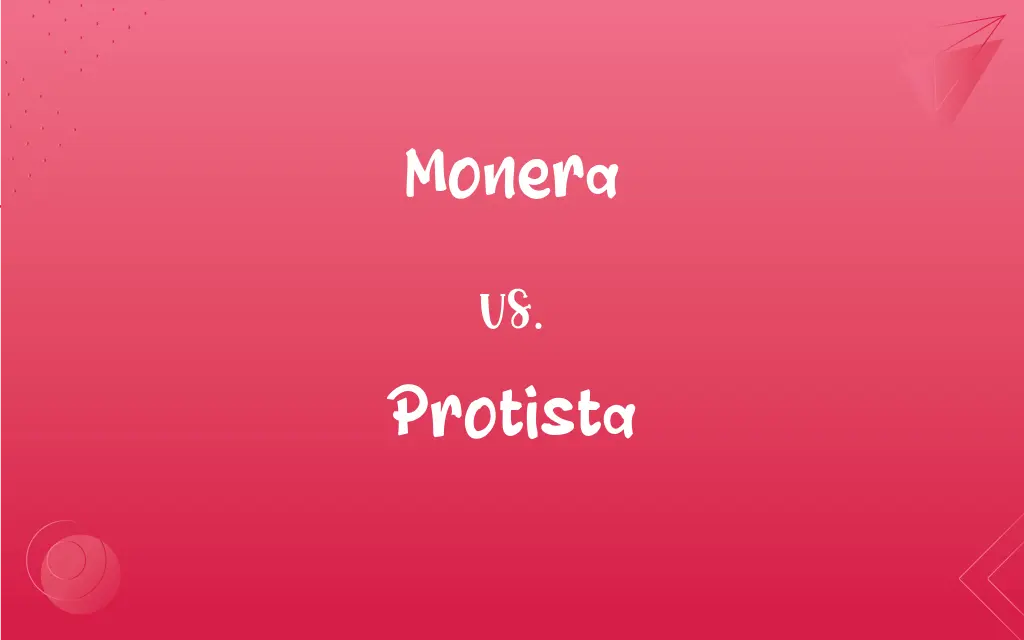Monera vs. Protista: What's the Difference?
Edited by Aimie Carlson || By Harlon Moss || Updated on October 29, 2023
Monera includes prokaryotic organisms, while Protista includes eukaryotic, single-celled organisms.

Key Differences
Monera and Protista are two distinct kingdoms in the biological classification system, each comprising diverse sets of organisms with unique characteristics. While Monera consists exclusively of prokaryotic organisms, primarily bacteria and blue-green algae (cyanobacteria), Protista is a group of eukaryotic organisms which includes protozoans, algae, and certain fungi. This means that members of the Monera kingdom lack a defined nucleus and membrane-bound organelles, whereas members of the Protista kingdom possess these cellular features.
In terms of nutritional methods, Monera and Protista show a wide variety. Many bacteria (from the Monera kingdom) are heterotrophic, relying on organic substances for nutrition. However, cyanobacteria, also a part of Monera, can perform photosynthesis. On the other hand, Protista encompasses both autotrophic organisms like the green algae, which can photosynthesize, and heterotrophic organisms like amoebas, which consume other microorganisms. So, while Monera is mainly split between photosynthetic and non-photosynthetic types, Protista boasts a broader range of nutritional strategies.
Reproduction in both Monera and Protista typically occurs asexually, but the mechanisms can differ. Most members of Monera, such as bacteria, reproduce through binary fission, where a single cell divides into two. Within Protista, while many also reproduce through binary fission, there are other methods like budding or multiple fission observed in various species. Furthermore, some protists undergo complex life cycles that involve sexual reproduction, introducing greater genetic variety, a feature less common in the Monera kingdom.
While both Monera and Protista have members that can be found in various environments, from soil to aquatic habitats, their interactions with other organisms differ. Many bacteria from the Monera kingdom play crucial roles in processes like nitrogen fixation and fermentation, impacting plants and other organisms. Some can also be pathogenic to plants, animals, and humans. In the Protista kingdom, some members, like certain algae, produce a significant portion of the world's oxygen, while others, like the malaria-causing Plasmodium, can be harmful pathogens.
In terms of diversity, both Monera and Protista are vast kingdoms, but their evolutionary significance differs. Monera represents some of the earliest life forms on Earth, and their fossil record provides clues about the conditions and life processes of ancient times. Protista, being eukaryotic, represents a more advanced stage of cellular evolution. The members of Protista have cellular complexities that are often intermediate between simpler prokaryotes of Monera and the more complex multicellular organisms found in other eukaryotic kingdoms.
ADVERTISEMENT
Comparison Chart
Cell Type
Prokaryotic
Eukaryotic
Nucleus
Absent
Present
Examples
Bacteria, Cyanobacteria
Protozoans, Algae, Slime molds
Cell Complexity
Simpler cell structure
Diverse and more complex cell structures
Monera and Protista Definitions
Monera
Organisms without a defined nucleus.
Organisms in Monera do not have a true nucleus.
ADVERTISEMENT
Protista
Kingdom of primarily single-celled eukaryotic organisms.
Amoebas are part of Protista.
Monera
The kingdom of life with prokaryotic organisms.
Bacteria belong to Monera.
Protista
Organisms with a clear nucleus.
Protista organisms have a well-defined nucleus.
Monera
Reproduces primarily through binary fission.
Most Monera reproduce by dividing into two.
Protista
Found mainly in aquatic environments.
Most of the Protista thrive in water bodies.
Monera
Organisms with a basic cellular structure.
Cyanobacteria in Monera have a simpler structure compared to eukaryotes.
Protista
Kingdom with a wide range of organisms.
Protista includes various forms from algae to protozoans.
Monera
Some of the oldest life forms on Earth.
Monera contains ancient organisms like bacteria.
Protista
Plural of protiston
Monera
Plural of moneron
Protista
A provisional group in which are placed a number of low microscopic organisms of doubtful nature. Some are probably plants, others animals.
Protista
Eukaryotic one-celled living organisms distinct from multicellular plants and animals: protozoa, slime molds, and eukaryotic algae
FAQs
What is monera?
Monera is a taxonomic kingdom that includes prokaryotic microorganisms like bacteria.
Do monera have a nucleus?
No, monera lack a defined nucleus; they have a nucleoid instead.
How do monera reproduce?
Most monera reproduce through binary fission.
Are monera unicellular or multicellular?
Monera are unicellular organisms.
How are protists different from other kingdoms?
Protists are a diverse group of eukaryotic microorganisms that don't fit into the plant, animal, or fungal kingdoms.
What types of organisms are classified under monera?
Bacteria and cyanobacteria (formerly known as blue-green algae) are classified under monera.
Are all monera harmful?
No, while some can cause diseases, many are beneficial or neutral to humans.
How do protists obtain energy?
Protists can be photosynthetic, heterotrophic, or mixotrophic.
Do monera have organelles?
Monera lack membrane-bound organelles.
Are protists unicellular or multicellular?
Most protists are unicellular, but some can be multicellular or colonial.
Do protists cause diseases?
Some, like the Plasmodium species causing malaria, can be pathogenic. However, many are harmless.
Where can protists be found?
Protists inhabit a variety of environments including freshwater, marine ecosystems, soil, and even within other organisms.
What are the main groups of monera?
The main groups are eubacteria (true bacteria) and archaebacteria (ancient bacteria).
How do monera differ from other kingdoms?
Monera are prokaryotic, meaning they lack a nucleus and membrane-bound organelles.
What are some common examples of protists?
Amoeba, Paramecium, and Euglena are common examples.
What types of organisms are classified under protista?
Protista includes a wide variety like algae, protozoans, and some fungi-like organisms.
Are monera autotrophic or heterotrophic?
Monera can be both; some perform photosynthesis, while others obtain energy from organic matter.
What is protista?
Protista is a taxonomic kingdom that includes eukaryotic microorganisms, which are neither plants, animals, nor fungi.
Do protists have a nucleus?
Yes, protists have a well-defined nucleus.
About Author
Written by
Harlon MossHarlon is a seasoned quality moderator and accomplished content writer for Difference Wiki. An alumnus of the prestigious University of California, he earned his degree in Computer Science. Leveraging his academic background, Harlon brings a meticulous and informed perspective to his work, ensuring content accuracy and excellence.
Edited by
Aimie CarlsonAimie Carlson, holding a master's degree in English literature, is a fervent English language enthusiast. She lends her writing talents to Difference Wiki, a prominent website that specializes in comparisons, offering readers insightful analyses that both captivate and inform.































































